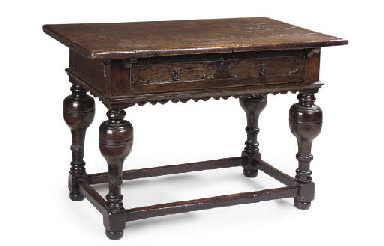Gateleg Table
This English, William and Mary style table is handmade furniture of oak. The gateleg mechanism enables the top to fold down. The bobbin-turned legs are joined by square stretchers.
This style was popular well into the 18th century, so such tables are difficult to accurately date.
English Table
This English refectory table is made of oak. The low stretchers indicate that the table has probably been reduced in height, which happens when the legs suffer termite or water damage.
It was possibly made for a manor house in Cornwall.
English Table
This Charles II table has a deep frieze without drawers, and carving that incorporates a Tudor rose. The cup-and-cover supports are typical for its date, but the four plank top has been added later.
Reeded cross stretchers are positioned between chamfered block feet.
Flemish Table
The rectangular top above a panelled drawer on turned baluster-shaped legs joined by stretchers, on bun feet, restorations and replacements including the lowest mouldings to the legs and stretchers, now common in reproduction furniture.

Spanish Table
The 1” thick, 2 plank top with rounded corners on this piece of non fitted furniture. The frieze fitted with 2 drawers with original locks and handles. Standing on tapering square legs, that have been reduced in height, joined by shaped side stretchers. Exceptional colour and patina. Spanish, second quarter of the 17th century.
No comments:
Post a Comment